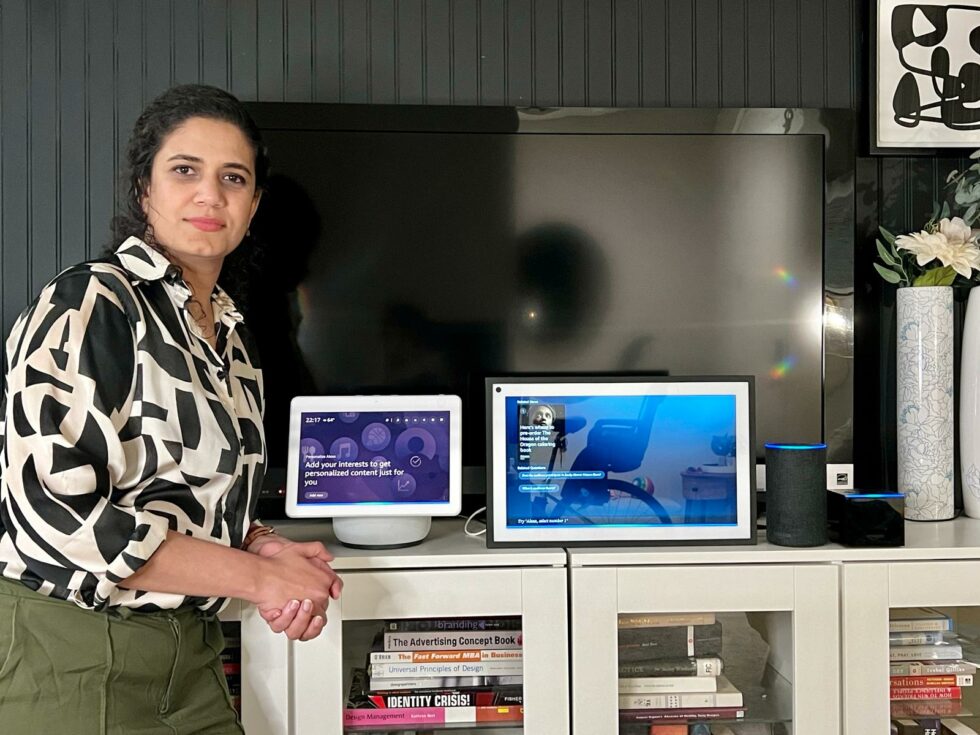
For over six years now, Alexa has been making its mark in India, evolving into a powerful personal assistant. Each new feature is tailored to meet the diverse needs of Indian customers, spanning from children to the elderly. Alexa is dedicated to addressing real customer needs by harnessing the full potential of its technology. The recent introduction of Widgets on Alexa’s Echo Show devices is a significant achievement, unveiling fresh features and functionalities for users while also providing a platform for developers to innovate. Understanding India’s rich cultural tapestry is crucial for delivering a personalised Alexa experience and presents opportunities for expanding Alexa’s skill set.
In this interview, we hear from Aparna Unnikrishnan, whose seven years of expertise in the Alexa organization have played a pivotal role in shaping over a dozen Alexa devices. Currently, she leads UX Design for Amazon Fire Tablets.
India is a land with different languages, different cultures, and perspectives, how does a product like Alexa take all this into consideration?
Alexa currently supports Hindi and various other languages, including US-English, UK-English, Canadian English, English with Australian or Indian accents, German, Japanese, Canadian French, French, Italian, Spanish (including variations such as Mexican and US), Portuguese, and Arabic. However, the technology has yet to reach a level where it can comprehend and process the broader set of Indian languages and their dialectical variations, along with the regional cultural contexts. This represents an area where technology needs to evolve to become more inclusive.
In a generic sense, there is a continual effort to inform and teach the system how people normally communicate with each other. Even for languages that AI systems support today, natural language understanding is still evolving. We hope that eventually, the system will learn to understand how we as humans naturally speak in our preferred languages, including dialectical variations and non-verbal cues, and respond appropriately. Design can also play a crucial role in bridging this gap. By providing interfaces that are intuitive for customers to operate, we can facilitate this communication, as evidenced by the widespread adoption of smartphones.
How can features of Alexa help or aid the common man of India, also consider a variety of use cases and needs of people across India and globally?
Firstly Alexa aims to meet diverse needs:Today Alexa caters to a wide range of common use cases, from listening to music, news, and visual content, to answering questions, making calls, sending messages, assisting with online orders, managing reminders (e.g electricity bills are due today), setting up routines (e.g when I wake up and say good morning, tell me today’s news), and supporting smart home automation. As a customer-centric organization, ongoing research efforts across different teams aim to identify and address unmet needs effectively. Understanding users’ contexts, preferences, and socio-cultural behaviours is essential for delivering personalised experiences.
Secondly we always try to enhance accessibility: In many cases, users perceive technologies like Alexa as inaccessible due to perceived complexity or fear of making mistakes during interactions. To address this, we design interfaces that are simpler to understand and make the interactions as intuitive as possible, where the system can hide the complex technology behind it and make it more welcoming and approachable for people to interact with it. Alexa Widgets and Widget shortcuts that our team developed, is an example of providing such an interface where we are making the features more visible to users, enabling them to use more or more of Alexa’s capabilities.
Thirdly we offer multiple modes of interaction: Alexa supports voice, touch, and visual inputs, adapting to the user’s preferred mode of interaction and device capabilities. This versatility broadens accessibility options, ensuring users can interact with Alexa in a manner that suits their needs. Additionally, on devices with screens, the user interface adjusts based on proximity to the screen, enhancing visual accessibility and usability.
Typically Alexa is playing music or helping make calls, that’s what is generally used most widely by a certain population. But above and beyond that how is Alexa helping people in their old age and the younger generation?
There are many Alexa features that are more useful and applicable for people of different ages and needs.
Alexa for Kids: Alexa has devices specifically designed for children, although the availability of these products and features may vary. Kid-friendly devices come equipped with “content filters” to ensure children access age-appropriate content. Knowing that it’s a kids device, Alexa even provides responses that are suitable for younger audiences. There are Alexa skills tailored to kids education and entertainment such as Animal Game, Amazon Math, Freeze Dancing, information quizzes etc.Additionally, there are specific Alexa features such as bedtime stories that engage children by taking turns reading with them. The whisper mode feature enables Alexa to respond in a hushed tone, minimising disruptions and ensuring calm interactions between much younger children and parents.
Alexa for Seniors:In an age where ageing populations are growing, maintaining independence while ensuring safety and well-being is crucial, and Alexa emerges as a significant ally. It combats loneliness and isolation by providing constant companionship through conversation, music, and calls to loved ones. Moreover, Alexa simplifies daily tasks, from reminders to jotting down notes, thereby enhancing convenience and independence for seniors. Additionally, it ensures safety through features like “Alexa Together,” which monitors well-being remotely through integrated sensors. Beyond functionality, Alexa also provides companionship, fostering emotional well-being. As technology advances, Alexa’s role in elderly care will likely expand, empowering ageing populations to live life to the fullest.
There is often worry that something like Alexa will over time take control and diminish privacy as its AI power increases. How do you perceive that?
When envisioning AI experiences, it’s common to conjure up images from futuristic movies and mainstream media where robots, humanoids, or highly intelligent virtual assistants dominate the narrative. While this portrayal isn’t entirely unfounded, the reality is that AI is already deeply ingrained in our lives in various forms. From navigation apps optimising our routes to recommendation systems personalizing our online experiences, versions of AI are already omnipresent. However, the true essence of AI lies not just in its technological prowess but in its ability to enhance the quality of life for individuals. I think we have currently not reached the point of creating true sentients that can think, feel, or comprehend, in a physical, mental, and emotional manner all encompassed as a single entity. AI has the potential to automate various tasks and processes, but it cannot fully replicate human capabilities such as creativity, empathy, and moral reasoning. While AI excels in certain domains, it often struggles with complex decision-making and understanding nuanced situations. Human oversight and intervention are necessary to mitigate biases and errors in AI systems. Ultimately, AI should be viewed as a tool to enhance human capabilities rather than as a complete replacement for humans. Collaboration between humans and AI can leverage the strengths of both, leading to more efficient and effective outcomes.
How much is AI influencing the younger generation of today? Can they imagine a life without these devices?
Like any tool or invention AI also has its pros and cons. Till date most of our critical inventions have been controversial in nature, whether that is the topic of vaccinations or internet or packaged food that we eat today. In a similar way, AI also has its pros and cons related to how it will affect the generations to come. On one hand, AI is helping the younger generation by providing them with personalised learning experiences through educational platforms, enhancing their understanding and retention of knowledge. And this can be applied into any domain and we can utilise AI to make the experience better and more helpful. But on the other hand, AI’s omnipresence can also pose risks, including privacy concerns, as it collects and analyses vast amounts of personal data. It may contribute to information bubbles, limiting exposure to diverse perspectives. Moreover, overreliance on AI for decision-making could hinder critical thinking skills and creativity, potentially leading to a passive consumption culture among young users. But in the future life with AI is going to be inevitable and one will need ethical design, awareness & governance to mitigate the risks.




